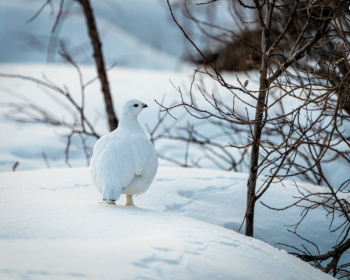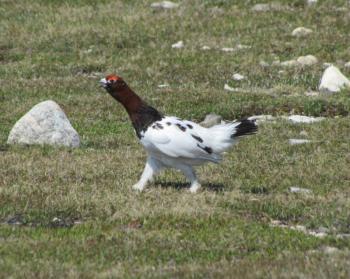A Rare Visitor from Far North
There is no doubt that the sight of an all-white, chicken-sized bird with feathered feet walking around on the ground somewhere here on the coast of Maine in spring would make just about anyone shake their head and blink their eyes in disbelief. For a birder, it would be particularly shocking as the possibilities for what it could be are pretty limited and all highly unusual.
The first thought might be that the bird was an albino of some kind. Maybe an albino ruffed grouse if it were walking around on the ground like a chicken. Someone else might wonder if it could be an odd barnyard wander like a Guinea hen or something released at a hunt club, like a chukar or pheasant, that has found itself in unfamiliar surroundings.
But then a close look reveals a rounded head with a black bill…and those feathered feet.
Such a sighting here in Maine is odd enough that anyone, birder or not, would probably take a photo of it. Fortunately, someone did a few weeks ago on Cliff Island. The photo eventually made its way to the broader bird world.
It was a willow ptarmigan! And there has been a recent report that it may have been seen again in the last few days in Phippsburg.
Willow ptarmigan, like their close relative the rock ptarmigan, are largely birds of Arctic and subarctic regions of North America, Europe, and Asia. The closest breeding areas to the Maine coast are at least 500 miles to the north in Quebec or Newfoundland. Willow ptarmigan make migratory movements, sometimes hundreds of miles to the south of breeding areas for the winter and then back again in the spring. In Alaska, birds have been seen passing through certain areas in the thousands and have even been seen passing by from boats well offshore.
So what would a willow ptarmigan be doing down here in Maine in the spring? The best explanation is that an occasional bird gets its north and south compass flipped around and migrates south when it should be migrating north.
There are seven or eight previous records of these northern grouse in Maine. Except for one undocumented report, all the other occurrences have been in April or May. The last one before this spring’s was on Great Chebeague Island in May 2000.
Interestingly, a willow ptarmigan was photographed outside of Quebec City in April of this year.
In April of 2022, someone was surprised to see one of these white birds on the side of the road in southern Massachusetts, so they photographed and videotaped it. A person did the same in northern Vermont in May of 2020, and lots of people got to see one in northern New York in April of 2014.
Willow ptarmigan are not rare birds in their normal range, but they sure don’t leave that northern range very often. What an amazing bird to visit Maine, and what a great experience for those lucky few to have seen it!
Jeffrey V. Wells, Ph.D., is a Fellow of the Cornell Lab of Ornithology and Vice President of Boreal Conservation for National Audubon. Dr. Wells is one of the nation's leading bird experts and conservation biologists. He is a coauthor of the seminal “Birds of Maine” book and author of the “Birder’s Conservation Handbook.” His grandfather, the late John Chase, was a columnist for the Boothbay Register for many years. Allison Childs Wells, formerly of the Cornell Lab of Ornithology, is a senior director at the Natural Resources Council of Maine, a nonprofit membership organization working statewide to protect the nature of Maine. Both are widely published natural history writers and are the authors of the popular books, “Maine’s Favorite Birds” (Tilbury House) and “Birds of Aruba, Bonaire, and Curaçao: A Site and Field Guide,” (Cornell University Press).
































.png)
.png)
